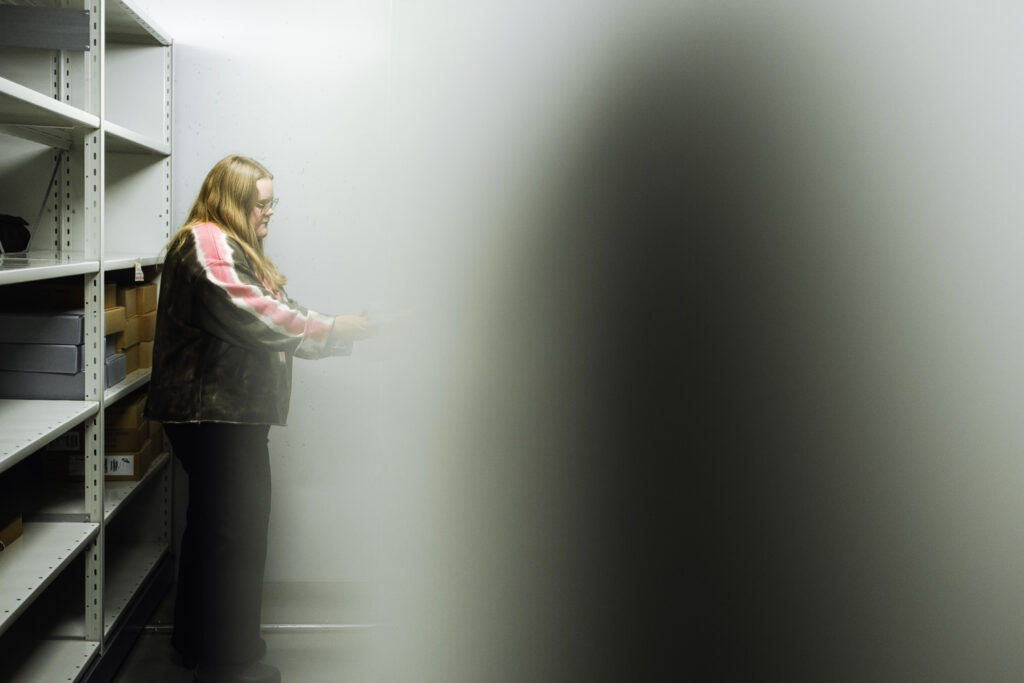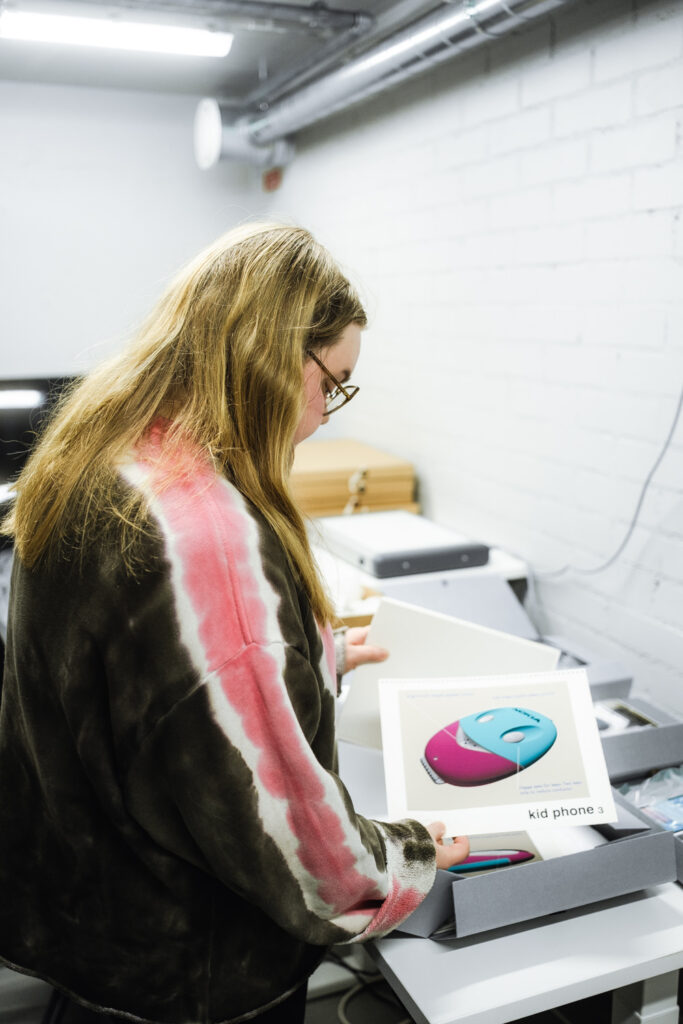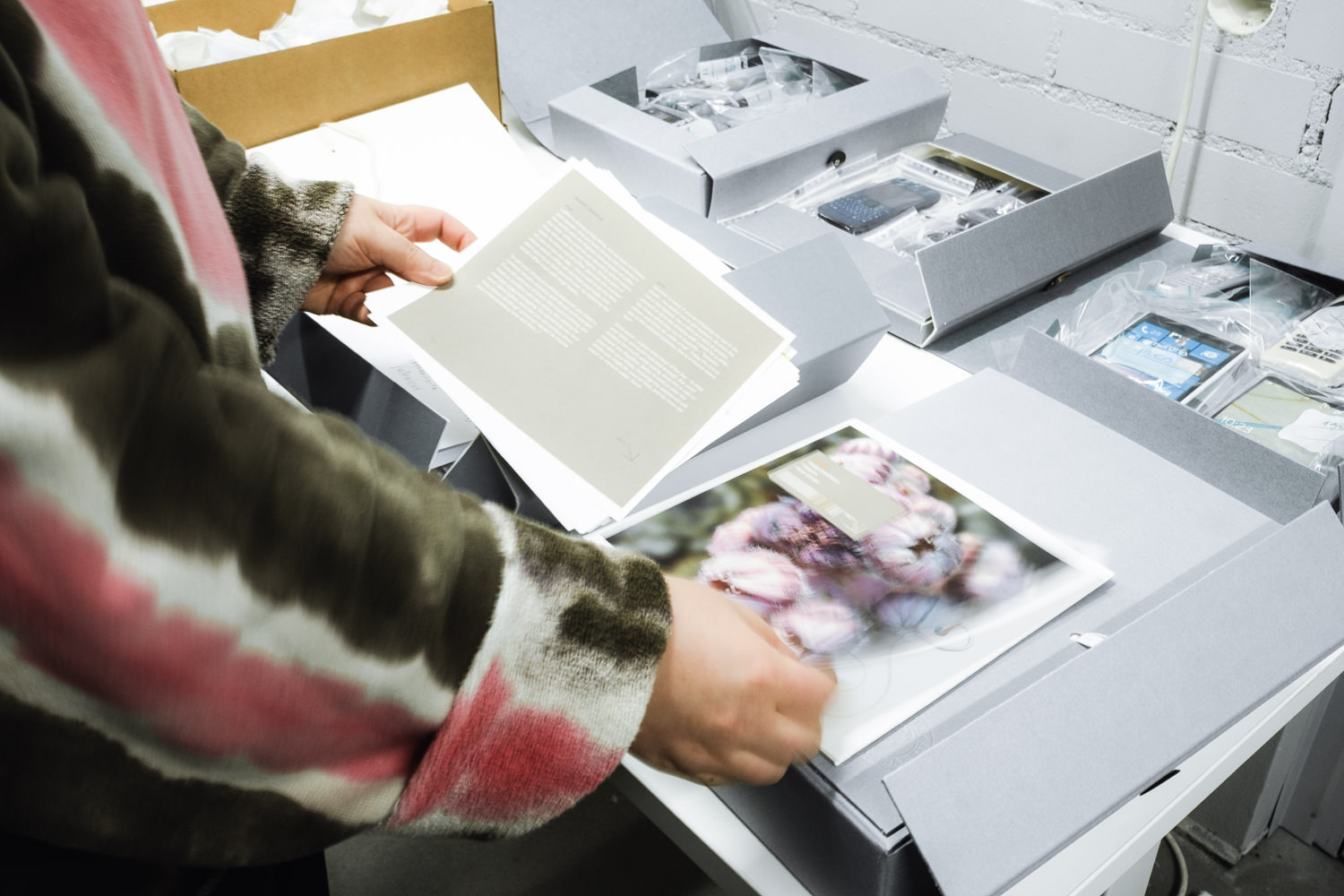Scentless and tasteless can still be of cultural and historical value. Behind what seems like an ordinary door lies a unique archive, assembled under the leadership of Aalto University’s Professor of Design, Anna Valtonen. Support from the KAUTE Foundation made the digitization of the archive possible.
The Nokia Design Archive can be explored from a home computer, but we have arrived at the heart of it all—Otaniemi. Our guide is Kaisu Savola, postdoctoral researcher and design historian at Aalto University, who moves effortlessly between the archive shelves. “I’ll see if I can find something interesting,” Savola says, lifting archive boxes onto a side table.
Before long, the archives have quite literally opened up, and the tabletop is covered with prototypes, authentic marker sketches, and design notebooks. Among them is even a stack of papers revealing that, even in Nokia’s golden years, there were already discussions about how mobile phones could be used for body measurements.
The research team has done an enormous amount of work. “The archive itself contains 20,000 items, but we curated 700 for the digital database —the most essential ones,” Savola notes. She also reminds us that this is viewed from a design perspective. “If we had received the material from UI designers or the marketing team, it would look completely different.”

Uncharted Paths of Nokia Design
Outside, the wind howls, but inside the archive, the air is delightfully musty. That’s a good sign—it means these fragments of Finnish design history are safe. Fortunately, Professor Anna Valtonen answered the call when a former Nokia colleague offered her the design archives. The material was swiftly transferred to Aalto University’s ownership, and eventually, funding was sought from the Academy of Finland to organize and study it.
Kaisu Savola joined the project through a happy coincidence. “Professor Valtonen was looking for researchers, and someone recommended me. We sat down to discuss the topic, and before I knew it, I was already co-writing the funding application,” Savola laughs. As a historian, she is drawn to broader societal themes, but after seeing the materials, she was intrigued: “I thought, ‘Wow, no one has really looked at Nokia from this perspective before.’”
The research team included Valtonen, Savola, the recommending professor Guy Julier, as well as Michel Nader Sayún, Pauli Pakarinen, and Lu Chen. “It was such a stroke of luck to be part of this—I never would have come up with this topic on my own. I’ve learned so much,” she says enthusiastically.
An Archive of People
Savola explains that the material has given her a new understanding of how technological development is fundamentally driven by people. “It’s not some autonomous force moving forward on its own. We, as humans, decide which technologies succeed, which get investment, and which ones governments choose to support,” she reflects. In her view, these processes are deeply human.
At its core, the Nokia Design Archive is also about people. It brings designers into the spotlight. “The role of designers in decision-making is fascinating. Are they included in the process at all? It’s not a given,” Savola muses. “On the other hand, a designer can wield immense power through their work. When design becomes part of everyday life, its influence is enormous.”

An Internal Conflict Led to London
Kaisu Savola’s approach to research is deeply human-centered. In her dissertation, she studied the values that shaped Finnish design in the 1960s and 1970s. “That was when public debates about the purpose of design really began. The post-war generations were growing tired of the capitalist foundations of design,” she explains.
There’s something similar in Savola’s own journey. She initially studied ceramic art, completing a bachelor’s degree, but friction grew along the way. “I felt an internal conflict. We were young people reading about overconsumption and the depletion of natural resources, yet none of that was reflected in our studies.” She realized she no longer believed she could change the world as a ceramicist.
When she eventually discovered design history as an academic discipline, everything fell into place. “I did my master’s studies in London, where I was able to focus on topics that truly mattered to me. I don’t want to be a designer myself, but I’m fascinated by design-related themes—consumption, technological development, the creativity of designers, and the role of design in everyday life.”
As a historian, Savola gets to do what she loves most: read and write to her heart’s content.
The Archive’s Popularity Came as No Surprise
The Nokia Design Archive was launched on January 15, 2025. Within the first week, Aalto University’s project page had already received over 17,000 visitors, and the number of guests exploring the digital archive was in the tens of thousands. By the end of February, the website had been accessed over 200,000 times. According to Savola, even popular research projects typically attract only a few hundred visits.
For the team, the archive’s success was no surprise. “From the very beginning, I knew this would be a big deal. It’s only natural that a company as significant as Nokia sparks interest,” Savola says. “But what did surprise me was how little the topic has been covered in Finnish media.” While thousands of articles have been written about it globally, domestic coverage has been notably scarce.

KAUTE Foundation Grant Opened the Archive’s Doors
Clicking through different nodes on the screen, an advertisement appears—filmed on the Linnanmäki roller coaster—showing happy people with mobile phones pressed to their ears. “Who among us hasn’t related to this imagery?” Savola laughs. The digital archive is a sprawling, interconnected collection that captivates its visitors.
Savola explains that the archive has multiple target audiences. Business leaders, for instance, can explore it to better understand the role of design in their organizations. But it also has a special message for collectors and today’s forty-somethings, who can indulge in nostalgia by browsing 1990s marketing materials.
KAUTE Foundation’s funding made the development of the online platform possible. Supporting knowledge-sharing initiatives like the Nokia Design Archive aligns well with the foundation’s strategy, as funding projects that spread information is one of its core missions. “Without digitization, you’d have to visit the archive here in Otaniemi—and that would be much more difficult,” Savola points out.
The KAUTE Foundation grant also allowed Aalto University to hire two top experts to conceptualize the digital archive. “The role of Michel Nader Sayún and Lu Chen cannot be overstated!” Chen, in particular, specialized in visualizing the archive. “That’s an area where I have no expertise at all,” Savola admits.
In many ways, the Nokia Design Archive is more than just an archive—it’s a testament to research that extends beyond its own scale. It has brought people together, just as a true Nokia project should. “Collaborating with others is incredibly valuable,” Savola concludes.
